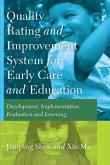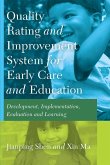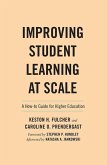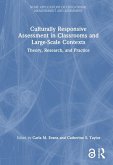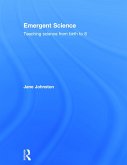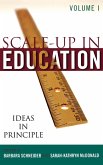Brenda Taggart, Denise Kingston, Iram Siraj, Kathy Sylva
Early Childhood Quality Rating Scale - Emergent Curriculum (ECQRS-EC)
Brenda Taggart, Denise Kingston, Iram Siraj, Kathy Sylva
Early Childhood Quality Rating Scale - Emergent Curriculum (ECQRS-EC)
- Gebundenes Buch
- Merkliste
- Auf die Merkliste
- Bewerten Bewerten
- Teilen
- Produkt teilen
- Produkterinnerung
- Produkterinnerung
The Early Childhood Quality Rating Scale - Emergent Curriculum (ECQRS-EC) is designed to measure the quality of support for literacy, mathematics, and science in pre-school settings.
Andere Kunden interessierten sich auch für
![Quality Rating Improvement System 'for' Early Care 'and' Education Quality Rating Improvement System 'for' Early Care 'and' Education]() Jianping ShenQuality Rating Improvement System 'for' Early Care 'and' Education40,50 €
Jianping ShenQuality Rating Improvement System 'for' Early Care 'and' Education40,50 €![Quality Rating Improvement System 'for' Early Care 'and' Education Quality Rating Improvement System 'for' Early Care 'and' Education]() Jianping ShenQuality Rating Improvement System 'for' Early Care 'and' Education145,20 €
Jianping ShenQuality Rating Improvement System 'for' Early Care 'and' Education145,20 €![Improving Student Learning at Scale Improving Student Learning at Scale]() Keston H. FulcherImproving Student Learning at Scale180,99 €
Keston H. FulcherImproving Student Learning at Scale180,99 €![Culturally Responsive Assessment in Classrooms and Large-Scale Contexts Culturally Responsive Assessment in Classrooms and Large-Scale Contexts]() Culturally Responsive Assessment in Classrooms and Large-Scale Contexts179,99 €
Culturally Responsive Assessment in Classrooms and Large-Scale Contexts179,99 €![Emergent Science Emergent Science]() Jane JohnstonEmergent Science192,99 €
Jane JohnstonEmergent Science192,99 €![Education on an International Scale Education on an International Scale]() George W. GrayEducation on an International Scale54,99 €
George W. GrayEducation on an International Scale54,99 €![Scale-Up in Education Scale-Up in Education]() Scale-Up in Education135,99 €
Scale-Up in Education135,99 €-
-
-
The Early Childhood Quality Rating Scale - Emergent Curriculum (ECQRS-EC) is designed to measure the quality of support for literacy, mathematics, and science in pre-school settings.
Produktdetails
- Produktdetails
- Verlag: Taylor & Francis Ltd
- Seitenzahl: 98
- Erscheinungstermin: 25. Juli 2025
- Englisch
- Abmessung: 297mm x 210mm
- ISBN-13: 9781032460420
- ISBN-10: 1032460423
- Artikelnr.: 72596988
- Herstellerkennzeichnung
- Libri GmbH
- Europaallee 1
- 36244 Bad Hersfeld
- gpsr@libri.de
- Verlag: Taylor & Francis Ltd
- Seitenzahl: 98
- Erscheinungstermin: 25. Juli 2025
- Englisch
- Abmessung: 297mm x 210mm
- ISBN-13: 9781032460420
- ISBN-10: 1032460423
- Artikelnr.: 72596988
- Herstellerkennzeichnung
- Libri GmbH
- Europaallee 1
- 36244 Bad Hersfeld
- gpsr@libri.de
Kathy Sylva is Professor of Educational Psychology at the University of Oxford. Iram Siraj is Professor of Child Development and Education at the University of Oxford, UK and Research Professor at the Froebel Department of Primary and Early Childhood Education at the University of Maynooth, Ireland. Brenda Taggart is Honorary Senior Research Associate at University College London, Institute of Education. Denise Kingston is a senior researcher at the University Oxford and Honorary Research Fellow at the University of Sussex.
Introduction to the Early Childhood Quality Rating Scale-Emergent
Curriculum (ECQRS-EC)
The underlying principles of the ECQRS-EC
Rationale for the development of new items and indicators in the ECQRS-EC
Content of the ECQRS-EC
Preparing to use the ECQRS-EC
Conducting the observation
Scoring the scales
ECQRS-EC and the 'spirit of the scales'
Making judgements
Use of supplementary (non-observation) evidence
Score sheet, joint observations sheets, and profile
Content of the scales
Subscale 1: Language and Emergent Literacy
Items
1 Environmental Print: Letters and words
2 Book and literacy areas
3 Adults reading with children
4 Sounds in words
5 Emergent writing/mark making
6 Talking and listening
7 Words and sentences
Subscale 2: Emergent Mathematics
Items
8 Counting and the application of counting
9 Understanding and representing number
10 Maths talk and thinking mathematically
11a Mathematical Activities: Shape
11b Mathematical Activities: Sorting, matching, and comparing
11c Mathematical Activities: Subitising
Subscale 3: Emergent Science
Items
12 Natural materials
13 Areas featuring science/science resources
14 Developing scientific thinking and the scientific process
15a Science Activities: Non-living
15b Science Activities: Living processes
15c Science Activities: Food preparation
Subscale 4: Supporting Diversity and Inclusion
Items
16 Planning for and supporting individual learning needs
17 Gender equality and awareness
18 Race equality and awareness
The ECQRS-EC information sheet
Rough plan of indoor and outdoor areas being observed
Score sheets
Joint observation/inter-rater reliability for the ECQRS-EC
ECQRS-EC Profile
References
Curriculum (ECQRS-EC)
The underlying principles of the ECQRS-EC
Rationale for the development of new items and indicators in the ECQRS-EC
Content of the ECQRS-EC
Preparing to use the ECQRS-EC
Conducting the observation
Scoring the scales
ECQRS-EC and the 'spirit of the scales'
Making judgements
Use of supplementary (non-observation) evidence
Score sheet, joint observations sheets, and profile
Content of the scales
Subscale 1: Language and Emergent Literacy
Items
1 Environmental Print: Letters and words
2 Book and literacy areas
3 Adults reading with children
4 Sounds in words
5 Emergent writing/mark making
6 Talking and listening
7 Words and sentences
Subscale 2: Emergent Mathematics
Items
8 Counting and the application of counting
9 Understanding and representing number
10 Maths talk and thinking mathematically
11a Mathematical Activities: Shape
11b Mathematical Activities: Sorting, matching, and comparing
11c Mathematical Activities: Subitising
Subscale 3: Emergent Science
Items
12 Natural materials
13 Areas featuring science/science resources
14 Developing scientific thinking and the scientific process
15a Science Activities: Non-living
15b Science Activities: Living processes
15c Science Activities: Food preparation
Subscale 4: Supporting Diversity and Inclusion
Items
16 Planning for and supporting individual learning needs
17 Gender equality and awareness
18 Race equality and awareness
The ECQRS-EC information sheet
Rough plan of indoor and outdoor areas being observed
Score sheets
Joint observation/inter-rater reliability for the ECQRS-EC
ECQRS-EC Profile
References
Introduction to the Early Childhood Quality Rating Scale-Emergent
Curriculum (ECQRS-EC)
The underlying principles of the ECQRS-EC
Rationale for the development of new items and indicators in the ECQRS-EC
Content of the ECQRS-EC
Preparing to use the ECQRS-EC
Conducting the observation
Scoring the scales
ECQRS-EC and the 'spirit of the scales'
Making judgements
Use of supplementary (non-observation) evidence
Score sheet, joint observations sheets, and profile
Content of the scales
Subscale 1: Language and Emergent Literacy
Items
1 Environmental Print: Letters and words
2 Book and literacy areas
3 Adults reading with children
4 Sounds in words
5 Emergent writing/mark making
6 Talking and listening
7 Words and sentences
Subscale 2: Emergent Mathematics
Items
8 Counting and the application of counting
9 Understanding and representing number
10 Maths talk and thinking mathematically
11a Mathematical Activities: Shape
11b Mathematical Activities: Sorting, matching, and comparing
11c Mathematical Activities: Subitising
Subscale 3: Emergent Science
Items
12 Natural materials
13 Areas featuring science/science resources
14 Developing scientific thinking and the scientific process
15a Science Activities: Non-living
15b Science Activities: Living processes
15c Science Activities: Food preparation
Subscale 4: Supporting Diversity and Inclusion
Items
16 Planning for and supporting individual learning needs
17 Gender equality and awareness
18 Race equality and awareness
The ECQRS-EC information sheet
Rough plan of indoor and outdoor areas being observed
Score sheets
Joint observation/inter-rater reliability for the ECQRS-EC
ECQRS-EC Profile
References
Curriculum (ECQRS-EC)
The underlying principles of the ECQRS-EC
Rationale for the development of new items and indicators in the ECQRS-EC
Content of the ECQRS-EC
Preparing to use the ECQRS-EC
Conducting the observation
Scoring the scales
ECQRS-EC and the 'spirit of the scales'
Making judgements
Use of supplementary (non-observation) evidence
Score sheet, joint observations sheets, and profile
Content of the scales
Subscale 1: Language and Emergent Literacy
Items
1 Environmental Print: Letters and words
2 Book and literacy areas
3 Adults reading with children
4 Sounds in words
5 Emergent writing/mark making
6 Talking and listening
7 Words and sentences
Subscale 2: Emergent Mathematics
Items
8 Counting and the application of counting
9 Understanding and representing number
10 Maths talk and thinking mathematically
11a Mathematical Activities: Shape
11b Mathematical Activities: Sorting, matching, and comparing
11c Mathematical Activities: Subitising
Subscale 3: Emergent Science
Items
12 Natural materials
13 Areas featuring science/science resources
14 Developing scientific thinking and the scientific process
15a Science Activities: Non-living
15b Science Activities: Living processes
15c Science Activities: Food preparation
Subscale 4: Supporting Diversity and Inclusion
Items
16 Planning for and supporting individual learning needs
17 Gender equality and awareness
18 Race equality and awareness
The ECQRS-EC information sheet
Rough plan of indoor and outdoor areas being observed
Score sheets
Joint observation/inter-rater reliability for the ECQRS-EC
ECQRS-EC Profile
References


